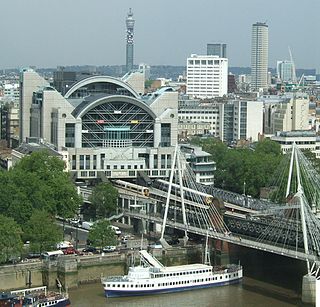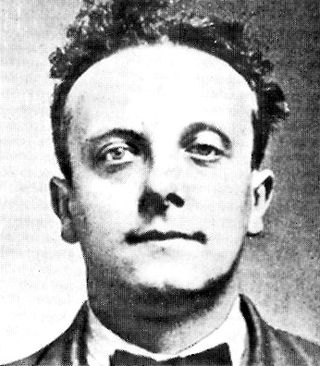
The Charing Cross Trunk Murder took place in a third floor office at 86 Rochester Row in the City of Westminster in London on 4 May 1927. [1]

The Charing Cross Trunk Murder took place in a third floor office at 86 Rochester Row in the City of Westminster in London on 4 May 1927. [1]
On 6 May 1927, [2] John Robinson, a 35-year-old estate agent, took a cab to Charing Cross railway station, where he deposited a large black trunk in the left-luggage office. [1] On 10 May after a "dreadful smell" was noted, the police opened the trunk to find the dismembered body of a woman, with each limb separately wrapped in brown paper. [1]
The shopowner who sold the trunk and the cab driver were traced, and the police that visited the office at No 86 said it was "hastily vacated but scrupulously clean". [1] Although the identity parade failed to pick out Robinson, a more careful search of the property found a matchstick in the bin with a small spot of blood.
A laundry tag on the dead woman's knickers for "P Holt" was traced to a Mrs Holt in Chelsea, who had employed ten women as servants over the past two years, and all were traced except for a "Mrs Rolls". [1] [3] [4] Holt confirmed that the head of the dead woman was that of Mrs Rolls, who turned out to be Minnie Alice Bonati, who had left her Italian waiter husband to live with a Mr. Rolls, and now used his name. [1] [3]
Bonati was working as a domestic servant and supplementing her income with prostitution. She had met Robinson at Victoria station, and they had gone to his office for sex. [1] [3] She died after an argument about money, with Robinson claiming that she attacked him, leading him to push her away, causing Bonati to fall, hit her head and die. [1] [3] He claimed that he panicked, bought a knife and trunk and disposed of the body, because he thought that no one would believe him. [1] [3] Robinson's story was contradicted by forensic pathologist Bernard Spilsbury, who said that Bonati had died of asphyxiation after being knocked unconscious, which could not have been caused by a fall as Robinson claimed. [3]
During his investigation Detective Inspector Grosse of the Metropolitan Police also pursued enquiries on behalf of a newspaper, an action which some held to be "reckless and unscrupulous" and argued should lead to the withdrawal of his pension. [2] After being produced as a trial exhibit, the trunk was retained in the collections of its private "Black Museum" (now the Crime Museum), where it was the subject of Episode 47 of the 1952 radio crime drama The Black Museum , with Orson Welles as both the host and narrator of the show. [5] [6] A version of the story (with names and dates changed) was dramatised in Dec 1951 as 'The Founier Case' episode of Whitehall 1212 (radio show). [7] A third dramatisation was broadcast as 'The Family Solicitor' in the 1949-51 series The Secrets of Scotland Yard with Clive Brook as the narrator [8]
The trunk was also loaned from the Crime Museum to the Crime Museum Uncovered exhibition at the Museum of London from October 2015 to April 2016. [9] [10]
Robinson was tried at the Old Bailey and convicted by Spilsbury's evidence that Bonati had been deliberately asphyxiated. He was sentenced to death by Mr. Justice Swift and hanged at Pentonville Prison on 12 August 1927.[ citation needed ]

Scotland Yard is the headquarters of the Metropolitan Police, the territorial police force responsible for policing Greater London's 32 boroughs. Its name derives from the location of the original Metropolitan Police headquarters at 4 Whitehall Place, which had its main public entrance on the Westminster street called Great Scotland Yard. The Scotland Yard entrance became the public entrance, and over time "Scotland Yard" came to be used not only as the common name of the headquarters building, but also as a metonym for the Metropolitan Police Service (MPS) itself and police officers, especially detectives, who serve in it. The New York Times wrote in 1964 that, just as Wall Street gave its name to New York's financial district, Scotland Yard became the name for police activity in London.

Charing Cross railway station is a central London railway terminus between the Strand and Hungerford Bridge in the City of Westminster. It is the terminus of the Southeastern Main Lines to Dover via Ashford and Hastings via Tunbridge Wells. All trains are operated by Southeastern, which provides the majority of commuter and regional services to south-east London and Kent. It is connected to Charing Cross Underground station and is near to Embankment Underground station and Embankment Pier.

The Black Museum is a radio crime-drama program produced by Harry Alan Towers, which was broadcast in the USA on the Mutual network in 1952. It was then broadcast in Europe in 1953 on Radio Luxembourg, a commercial radio station, and was not broadcast by the BBC until 1991.

The murder of Vera Page is a British unsolved child murder case from the early 1930s. On 14 December 1931, 10-year-old Vera Page was reported missing after she failed to return to her home in Notting Hill, London, from a visit to a nearby relative. The child's body was found two days later in undergrowth in nearby Addison Road. Vera had been raped, then manually strangled to death in a murder described by one detective as "the most terrible in which I had to deal with during my career".

Sir Bernard Henry Spilsbury was an English pathologist. His cases include Hawley Crippen, the Seddon case, the Major Armstrong poisoning, the "Brides in the Bath" murders by George Joseph Smith, the Crumbles murders, the Podmore case, the Sidney Harry Fox matricide, the Vera Page case, and the murder trials of Louis Voisin, Jean-Pierre Vaquier, Norman Thorne, Donald Merrett, Alfred Rouse, Elvira Barney, Toni Mancini, and Gordon Cummins. Spilsbury's courtroom appearances became legendary for his demeanour of effortless dominance.

George Joseph Smith was an English serial killer and bigamist who was convicted and subsequently hanged for the murders of three women in 1915. The case became known as the Brides in the Bath Murders. As well as being widely reported in the media, it was significant in the history of forensic pathology and detection. It was also one of the first cases in which striking similarities between connected crimes were used to prove guilt, a technique used in subsequent prosecutions.

Wyllis Oswald Cooper was an American writer and producer.

Fanny Adams was an eight-year-old English girl who was murdered by a solicitor's clerk, Frederick Baker, in Alton, Hampshire, in 1867. Her murder was extraordinarily brutal and caused a national outcry in the United Kingdom. Baker abducted Adams and took her into a hop garden near her home, where he killed and dismembered her; some parts of her body were never found. An investigation suggested that two small knives were used for the murder, but it was later ruled they would have been insufficient to carry out the crime and that another weapon must have been used.

The Crime Museum is a collection of criminal memorabilia kept at New Scotland Yard, headquarters of the Metropolitan Police Service in London, England. Known as the Black Museum until the early 21st century, the museum came into existence at Scotland Yard sometime in 1874, arising out of the collection of prisoners' property gathered as a result of the Forfeiture Act 1870 and intended as an aid to the police in their study of crime and criminals. Initially unofficial, it had become an official if private museum by 1875, with a police inspector and a police constable assigned to official duty there. Not open to the public, it was used as a teaching collection for police recruits and was only ever accessible by those involved in legal matters, royals and other VIPs.
The cleft chin murder was a killing which occurred as part of a string of crimes during 1944, and was mentioned in George Orwell's essay "Decline of the English Murder". It became known as the "cleft chin murder" because the murder victim, George Edward Heath, a taxi driver, had a cleft chin.
The Brighton trunk murders were two murders linked to Brighton, England, in 1934. In each, the body of a murdered woman was placed in a trunk. The murders are not believed to have any connection with each other aside from how they were carried out, and the first of the two victims remains unidentified; a suspect was arrested and tried for the second murder but was found not guilty.

Dorothea Nancy Waddingham was an English nursing home matron who was convicted of murder.

Herbert Rowse Armstrong TD MA was an English solicitor and convicted murderer, the only solicitor in the United Kingdom ever hanged for murder. He was living in Cusop Dingle, Herefordshire, England, and practising in Hay-on-Wye, on the border of England and Wales, from 1906 until his arrest on 31 December 1921 for the attempted murder of a professional rival by arsenic poisoning. He was later also charged with, and convicted of, the murder of his wife, the crime for which he was executed.

Gordon Frederick Cummins was a British serial killer known as the Blackout Killer, the Blackout Ripper and the Wartime Ripper, who murdered four women and attempted to murder two others over a six-day period in London in February 1942. He is also suspected of committing two earlier murders in October 1941. Convicted of the murder of 34-year-old Evelyn Oatley, Cummins was sentenced to death and hanged at HMP Wandsworth on 25 June 1942.
Percy Kellick Hoskins was the chief crime reporter for the British newspaper the Daily Express in the 1950s. He also provided stories for radio and television crime shows, such as Whitehall 1212, and Secrets of Scotland Yard.

The Crumbles Murders are two separate and unrelated crimes which occurred on a shingle beach located between Eastbourne and Pevensey Bay, England—locally referred to as "the Crumbles"—in the 1920s. The first of these two murders is the 1920 bludgeoning murder of 17-year-old Irene Munro, committed by two men: Jack Field and William Gray. The second murder to occur upon the Crumbles is the 1924 murder of 38-year-old Emily Kaye, who was murdered by her lover, Patrick Mahon.

Sidney Harry Fox was a British petty swindler and convicted murderer. He was executed for the murder of his mother in an attempt to obtain money from an insurance policy on her life. His case is unusual in that it is a rare example of a known matricide in the United Kingdom.

The Camden Town murder was a murder which took place in Camden Town, London, England, in 1907. Robert Wood, an artist, was tried for the murder of sex worker Emily Dimmock and acquitted after a defence by Edward Marshall Hall.
Whitehall 1212 was a weekly crime drama radio show in the United States that ran from November 18, 1951 until September 28, 1952. Its cases were taken from the files of New Scotland Yard's Black Museum.

Rochester Row is a street in the City of Westminster in London that runs between Greycoat Place in the north and Vauxhall Bridge Road in the south.
{{cite book}}: CS1 maint: location missing publisher (link)